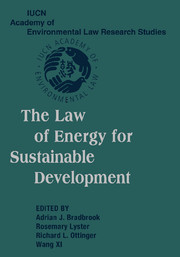Book contents
- Frontmatter
- Contents
- Acknowledgments
- Message from Kofi A. Annan, Secretary-General, United Nations
- Introduction – A Global Learned Society to Address Earth's Evolution: The IUCN Academy of Environmental Law
- Public Lectures on International Environmental Law
- PART ONE SUSTAINABLE DEVELOPMENT AND THE ROLE OF ENERGY LAW
- PART TWO LEGAL ISSUES IN CONTEMPORARY ENERGY LAW
- PART THREE INTERNATIONAL ENERGY LAW
- PART FOUR COMPARATIVE ENERGY LAW
- PART FIVE ELECTRICITY RESTRUCTURING
- PART SIX FINANCING FOR SUSTAINABLE ENERGY
- PART SEVEN CIVIL SOCIETY AND THE PROCEDURAL REQUIREMENTS OF ENERGY LAW FOR SUSTAINABLE DEVELOPMENT
- Index
Introduction – A Global Learned Society to Address Earth's Evolution: The IUCN Academy of Environmental Law
Published online by Cambridge University Press: 10 August 2009
- Frontmatter
- Contents
- Acknowledgments
- Message from Kofi A. Annan, Secretary-General, United Nations
- Introduction – A Global Learned Society to Address Earth's Evolution: The IUCN Academy of Environmental Law
- Public Lectures on International Environmental Law
- PART ONE SUSTAINABLE DEVELOPMENT AND THE ROLE OF ENERGY LAW
- PART TWO LEGAL ISSUES IN CONTEMPORARY ENERGY LAW
- PART THREE INTERNATIONAL ENERGY LAW
- PART FOUR COMPARATIVE ENERGY LAW
- PART FIVE ELECTRICITY RESTRUCTURING
- PART SIX FINANCING FOR SUSTAINABLE ENERGY
- PART SEVEN CIVIL SOCIETY AND THE PROCEDURAL REQUIREMENTS OF ENERGY LAW FOR SUSTAINABLE DEVELOPMENT
- Index
Summary
Law, as the manifestation of the human drive to live within an ordered society, has been at the center of life in all nations and in all civilization. Law always had a regard for nature, as the ancient Chinese pictogram for the law, FA, makes clear. However, until the late nineteenth century, law took nature for granted. As the industrial revolution emerged, as the scientific revolution brought to Earth the perspectives from space, and as human populations placed unprecedented demands on Earth's natural resources to meet human needs and wants, humans began to induce an evolution in the planet. Deserts have grown, the Aral Sea has dried up, species have become extinct, urban settlements have become vast conurbations producing ever greater demands for housing, food stuffs, jobs, potable water, and energy.
It is not only natural that the field of law should address these phenomena, as a matter of simple justice law it must. No international authority mandated that the field of environmental law should be established. The field emerged in the 1970s, and now exists in all nations and as a growing element of international law. As the norms of environmental law have made clear, it also has become clear that much of the implementation of these norms remains unrealized. Much of this is due to the lack of trained personnel and deficiencies in the legislation comprising the first generation of environmental laws.
- Type
- Chapter
- Information
- The Law of Energy for Sustainable Development , pp. 1 - 5Publisher: Cambridge University PressPrint publication year: 2005



